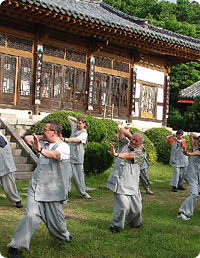SPECIAL INTEREST
Korea by Bike 19 days
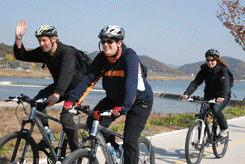
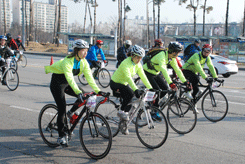
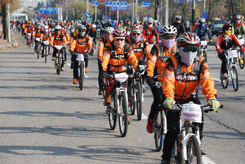
Tour Highlights
- Gyeongbokgung Palace
- National Folk Museum of Korea
- Insadong
- Namdaemun Market
- Peace Dam
- The 4th Tunnel
- Eulji Observatory
- Hangyeryeong Pass
- Misan Valley
- Unduryeong Pass
- Hwaam mineral spring
- Hwangji Pond
- Dosanseowon Confucian Academy
- Hahoemaeul Village
- Andong Folk Museum
- Gyeongju National Museum
- Cheomseongdae Astronomical Observatory
- Tumuli Park
- Bulguksa Temple
- Seokguram Grotto
- Beomeosa
- Haeundae Beach
- UN Memorial Cemetery
- Jagalchi Fish Market
Tips on Korean names
Expressway - 고속국도
National Road - 국도
Provincial Road - 지방도
City. County Road - 시. 군도
Other Road - 기타도로
Railroad - 철도
Bike Lane, Bike Path, Bikeway - 자전거도로
Sharp curve - 급커브
Steep gradient - 급경사
Usually named with following Korean suffixes stand for
Ro (로) - Road or Street
Daero (대로) - Main Street or Thoroughfare
Gil (길) - Road or Street
Ri (리) - Village
Maeul (마을) - Village
Dong (동) - Administrative unit in the city or village
Myeon (면) - Small County
Eup (읍) - Large County
Gun (군) - Administrative unit covering Myeon and Eup
Si (시) - City
Do (도) - Province
Cheong (청) - Office of Gun, Si or Do
Samuso (사무소) - Office
Samgeori (삼거리) - Fork or Junction
T Junction (T자형 삼거리)
Gyocharo (교차로) - Crossroads or Intersection
Sageori (사거리) - Crossroads or Intersection
Negeori (네거리) - Crossroads or Intersection
Nadeulmok (나들목) - Interchange
Gyo (교) - Bridge
Daegyo (대교) - Long Bridge
Yeok (역) - Subway station, Railroad station
Tunnel (터널) - Tunnel
Jihado (지하도) - Underpass
Guldari (굴다리) - Underpass
Jae (재) - Pass or Hill
Ryeong (령) - Mountain pass
Road signs are almost always in English as well as Hangeul.
Language is less of a problem than it might seem - many people understand some English.
Riding on any of the major roads can be physically and mentally exhausting and frustrating, traffic in general has little respect for your cycling plight.
Accommodation in motels or pensions is ubiquitous, standard and economical.
Vegetarian menus in some restaurants are rare to find.
Tour from April through October |
| Tour facts and features | |
| Accommodation | 18 hotel and pension nights in 2 and 4 star twin share accommodation |
| Meals | 8 breakfasts |
| Transport | All transportation by private vehicle, and speed train |
| Guided | Services of an English speaking guide |
| Group size | Maximum 9 |
| Age range | 18+ |
| Activity | Cycling of 12 days |
| Degrees of difficulty | Very difficult |
Note
Any figures like distance, times or road conditions stated in the bicycling program are estimate and just for guideline purpose
You need to understand you are responsible for your safety and health
Riding at proper speed, yielding right-of-way, not riding while under the influence of alcohol
The ride is strictly during the day, not before sunrise or after sunset
The riding will not be arranged on bad weather conditions such as extremely hot, cold, windy, foggy or rainy days. In such case, supporting vehicle cares the transportation of your bicycles
We provide bicycles and a set of fixing tool for the group
You are required to bring your helmet, highly visible or reflective clothing for low-visibility conditions
Cyclists need to follow the same rules as motorists
Always use correct hand signals before turning
Ride in single file with traffic, not against it
Bikeways are well established in areas, but much of roads are sharing with pedestrians, bicyclists and motorists. You need to understand how to safely and courteously share the road
Bicyclists need to be aware of their surroundings. Watch for opening car doors, sewer grating, debris on the roads, uneven surfaces, and poorly lit tunnels
Click on the days to access the programs quick
| Days | Visits and Activities | Distance |
| Day 1 | Arrive Seoul | 60km |
| Day 2 | Seoul | |
| Day 3 | Seoul - Paldang - Cheongpyeong - Gapyeong | 86km |
| Day 4 | Gapyeong - Chuncheon - Hwacheon | 57km |
| Day 5 | Hwacheon - Peace Dam - Bangsan | 50km |
| Day 6 | Bangsan - Haean | 38km |
| Day 7 | Haean | |
| Day 8 | Haean - Wontong - Hangyeryeong - Girin | 74km |
| Day 9 | Girn - Sangnam Samgeori- Misan Valley - Wongdang Samgeori - Jangchon Samgeori - Unduryeong - Soksa - Jinbu | 86km |
| Day 10 | Jinbu - Suhangri - Najeonri - Deoksongri - Jeongseon | 42km |
| Day 11 | Jeongseon - Hwaam - Taebaek | 65km |
| Day 12 | Taebaek - Andong | 115km |
| Day 13 | Andong | |
| Day 14 | Andong - Hahoe - Yonggi | 76km |
| Day 15 | Yonggi - Yeongcheon - Gyeongju | 128km |
| Day 16 | Gyeongju | |
| Day 17 | Gyeongju - Busan | 110km |
| Day 18 | Busan - Seoul | 450km |
| Day 19 | Departure | 60km |
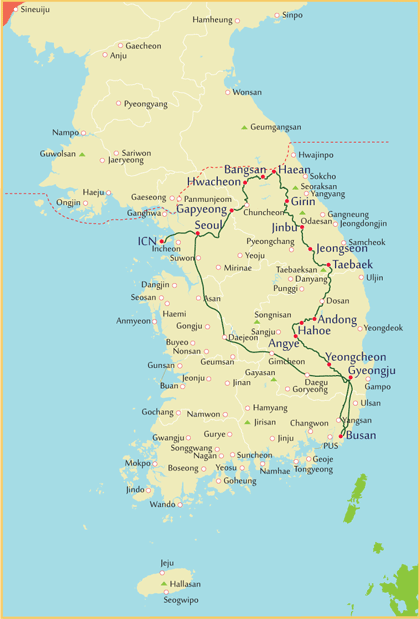 Day 1 Arrive Seoul (- - -)
Day 1 Arrive Seoul (- - -)
60km
Touching down at Incheon International Airport places you in the heart of Korea. After you clear Passport and Customs control, you will be welcomed by the tour guide and then transferred to your hotel.
Upon check in, pick up your bike and time for fitting.
Pedals, cleats, cycling shoes, crank arm length, saddle selection, height, fore/aft and tilt, handlebars, brake levers, etc.
A proper bike fit is essential so that you can produce the most power, most efficiently, meaning you have a position on the bike that lets you ride as long as you want, and stay comfortable the entire time.
The evening is yours to relax, allowing your mind and body time to adjust to different time zone.
Day 2 Seoul (B)
Your exploration this morning begins with a driving tour of Seoul, featuring sites such as Seoul Plaza, City Hall, Cheonggye Square and pedestrian-friendly Gwanghwamun Plaza that is hemmed in on both sides by rushing traffic and office buildings.
Step back in time to when life was gracefully slow and discover Gyeongbokgung Palace, a particularly charming spot that represents a colorful and turbulent side of the capital's 500-year history. Depending on timing, you may witness the Royal Guard Changing Ceremony featuring parade, password verification, duty shift and patrolling the gate. Accompanied by a court band with its colorful costumes and royal flags, the ceremony is performed daily basis at 10:00 and 14:00 except Tuesdays, although it is cancelled in case of rain or extremely hot or cold weather.
Your visit to the National Folk Museum of Korea will familiarize you with wealthy culture of this friendly and picturesque nation. It is an excellent facility to illustrate the history of traditional life of the Korean people from the prehistoric age to the Joseon dynasty. The permanent exhibition features life and work, costumes and ornaments, handicrafts and technology, educations, living quarters, dietary life, oriental medicine, performing arts and games, beliefs and rituals, and
socio cultural life.
Insadong, at one time the center of traditional Korean art and antiques, features a mixture of historical and modern atmosphere representing the cultural glimpse of the nation. Clustered along the main street and alleys are lined with street vendors, wooden tea houses, restaurants and numerous galleries and shops dealing in antiques, oriental art supplies, and modern Korean art of all types and styles. Soak in the paintings, upscale artworks, antiques and potteries while you can. Get lucky and you just might meet the artist themselves. It can be plenty of fun walking on the main street, but you venture into the hidden alleys that do spring some unexpected surprises. While here, you may want to buy some souvenirs or simply wander and browse at leisure admiring cultural ambience.
You will tour the centuries-old Namdaemun Market brimming with well over 11,000 shops selling anything you can imagine. One of the most colorful aspects of the market is an endless sprawl of street-vendor stalls that setup in the alleys and walkways between the buildings. The market is seriously crowded, so be prepared to get bumped around. A fantastic place to haggle over the price to get the best deal on something you want or simply admire the vibrancy of this massive market.
At the western entrance of the market in the middle of a traffic circle stands Sungnyemun. It is a formidable and iconic construct that served as the southern gate of the wall that surrounded Seoul during the period of the Joseon Dynasty.
Day 3 Seoul - Paldang - Cheongpyeong - Gapyeong (B) 86km
The route is a combination of bikeway and Road 403 and Road 407.
The day's tour may roughly break into three sectors, Banpo to Ungilsan station (41km), Unglisan station to Sincheongpyeong Daegyo Bridge (23km) and from the bridge to Gapyeong (22km).
Start your trip at Banpo and head up to Paldang bridge (팔당대교) on a traffic free bikeway. As you cross the bridge, the route picks up an old railway line leading to Ungilsan station and all the way to Gapeyong (가평), a beautiful town set by the mountains, rivers and lakes. It is one of the favorite relaxing and vacation destinations in the region.
Day 4 Gapyeong - Chuncheon - Hwacheon (B) 57km
Your tour covers most of the length of the country, enjoying a limited flat and rolling path to the the high mountain passes with a degree of valley every day. More suited for highly experienced bicyclists. The first part of the path to Chuncheon (32km) is a bikeway which is pretty flat and pleasant. You will cycle through roads that offer impressive landscapes, crossing charming villages and sharing with their people. Crossing Gyeongganggyo bridge (경강교), turn right at the end of the bridge and make your way down to the riverside and turn right to get to the bikeway. About 13km ahead is Gangchon Bridge (강촌교). Upon crossing it, follow a bike path leading down to the riverside. Continue your way for 19km past animation museum and cross Sinmaedaegyo bridge (신매대교) to Chuncheon, a scenic city surrounded by lakes and mountains.
Soon after crossing the bridge, make a left turn and on to Sindong Samgeori (신동삼거리) where a challenging mountain trail begins. A combination of Road 403 and 407 leads you to Hwacheon (25km).
There is a Budari Tunnel (2,067m) on Road 403. So far, on the left side of the road near the tunnel entrance, there is a paved old road which is barricaded to block the traffics. After 2.5km biking on this road, turn right leading to Samhwari and finally Hwacheon.
Day 5 Hwacheon - Peace Dam - Bangsan (- - -) 50km
The word of the day is Road 460 highlighted by a long stretch of climbs and then descents with a degree of valleys. The day will be a relentless series of sweaty grunts and groans uphill followed often by a tunnel. About 16km of cycling in the gentle river valley ends up at Pungsan 2 ri (풍산2리), and by making a right turn, a challenging 34km journey continues. The road elevation abruptly rises up and villages or farmlands are seldom seen, but only get the feeling of locked in the mountains. It generally has very light traffic volumes so the lack of development of this remote area. Be prepared for a series of tunnels. Although they are well lit and have adequate shoulders, a tail reflector and a flashing rear light would be necessary.
Past Haesan tunnel (1.986m), which is the northernmost tunnel and built on the highest elevation in South Korea, then followed by Jaean tunnel (142m), Daebung tunnel (270m), and view the Peace Dam, 125m high and 601m wide. It was built to stave off possible catastrophic flooding should the upstream Imnam Dam in North Korea collapse, either intentionally or by accident. The dam was completed in 2005. As it stands, the dam has no reservoir, and is merely preventive.
Take time to see World Peace Bell that was made from empty cartridge cases gathered from the world’s conflict zones in that it carries a significant meaning. The bell weights 37.5 ton but is incomplete. Check out a broken pigeon wing that is on display near the bell. It will be added bringing the bell complete on the day of unification of Korea.
There is a Water Culture Center . Although it is small, an excellent facility to get familiar with the story of water, and the importance of water conservation.
After a short downhill and valley ride, a challenging uphill continues again. More tunnels including Pyeonghwa (173m), Yanghwa (329m), Ocheon (1,280m), and Dogo are on the way before allowing you to get to Bangsan. A long stretches uninterrupted by intersections and stop signs, the roadway gives you a feeling of being slightly more remote than does the river valleys. The trails are scenic and give a good sense of quiet even on week days.
Day 6 Bangsan - Haean (- - -) 38km
Road 460, Road 31 and Road 453 are the trails for the day.
Mountains are endless and still high. Past the villages like Omi, Geumak, Jangpyeong and Gobangsan. Shortly after Dogo tunnel (639m), make a left turn to jump on the Road 31 to the direction of Haean. After a short ride in the valley that hugs tiny villages like Deokgok, Imdang and Wolwun, take a Road 453 at the last fork before Wolwun reservoir and head on to Haean. Another challenge is Dosolsan mountain that stands high ahead. Part of the Dolsanryeong is 1,050 mhigh. Nothing like a never ending hill to finish your day. After the pass is a welcoming Punch Bowl, a natural geologic bowl several kilometers across ringed by steep mountains on four sides, The bowl creates the richest farmland, and the area is starkly beautiful. However, many fierce battles were fought here during the Korean War because of its strategic location. The Battle of Bloody Ridge took place here from August to September 1951 and this was followed by the Battle of Heartbreak Ridge from September to October 1951, meanwhile the 1st Marine Division reinforced by the Korean Marine Corps Regiment captured the line of hills in the Battle of the Punch Bowl from 31 August to 20 September 1951.
Day 7 Haean (B)
Day at leisure for refreshment. You may want to join the tour coverng the 4th tunnel dug secretly by the North and Eulji Observatory. The tour does not run on Mondays. The 4th tunnel was found on March 3, 1990. The tunnel is dug through the solid granite base in the depth of 145 meters underground. The tunnel stretches 2.1km southward across the Military Demarcation Line. Unlike three other tunnels, visitors will make a short monorail trip inside the tunnel.
Eulji Observatory is set one of the bitterest battlegrounds fought in the Korean War. Perched on a peak rising 1049m above sea level near the Military Demarcation Line, it is now one of the most informative relics dating back to the Korean Conflict. From the Eulji Observation Platform, North Korea soldiers on guard are visible.
Day 8 Haean - Wontong - Hangyeryeong - Girin (- - -) 74km
The itinerary will take you through small villages, filled with tradition and with the special charm of the people who inhabit them. Road 453, Road 46, Pillaero and Haseoksanro are the trails for the day.
A 30km of a gentle winding valley with couple of hills extends to Wontong. At Wontong Rotary, take a Wontongro and proceed to the Wontong Gyocharo (원통교차로). Jump on Road 44. About 3km ahead is another junction, Hangye Gyochar (한계교차로).
Take a Road 46 to Hangyeryeong. A strenuous cycling of 20km on a slope way continues to Hangyeryong (920m) and then steep descend of about 700m. Do not miss this point. Here, take a Phillaro to the right and continue 11km to the junction and jump on Road 31 to cross the Garisan 1 gyo Bridge (가리산 1교) to the left. About 700m ahead is another junction. Take a left fork and ride 13km to Girin.
Day 9 Girn - Misan Valley - Unduryeong - Soksa - Jinbu (B) 86km
Today is one of the most challenging rides of the tour. But, the autumn here is unique thanks to its colors and contrasts, creating a beautiful and cozy landscape. The steep mountains and winding roads along the stream encourage you to pedal on your bike harder. The harder you pedal the more spectacular scenes you can see.
A steep Omijae Passs (684m) and pleasant downhill riding with scenic gentle valleys. Then, journey on a Road 31 for 25km over Unduryeong Pass (1,089m) to Soksa Samgeori (속사삼거리). Turn left and continue on to Jinbu for 10km on a combination road of Soksajaegil (6km) and Gyeonggangro (4km). A chain of mountains stand high and valleys are sparsely dotted with tiny yet peaceful retired villages..
Day 10 Jinbu - Najeonri - Deoksongri - Jeongseon (- - -) 42km
The mountains are still high and the roadways are winding along the river valleys. Overall elevation is low and the slope is gentle downhill to Jeongseon. However, three tunnels await. You are escorted by supporting vehicle behind you.
Day 11 Jeongseon - Hwaam - Taebaek (- - -) 65km
Path finding seems to be difficult, but not really it is. Your cycling is a true connection with the natural space. In addition, sharing unique moments with your locals and learning more about their lifestyle. A delight for all your senses, an immersion into the traditional towns with unique charm. A challenging day with endless mountains and winding valleys. A short detour gets you to Hwaam mineral springs. At Samsuryeong Pass, highland cabbage farms along with a group of wind power turbines also await you. While in Taebakek, tour the source of Nakdong river. Hwangji pond, springing up 5,000 tons of water daily.
Day 12 Taebaek -
Andong (B) 115km
Winding uphills prevent your advance.
The first part of the riding in Taebaek is on a crowded rushing 2-lane road. Then followed by steep mountain path. The nature is beautiful, but roadway is rather narrow yet risky with much of constructions. Having made a right turn at Yuksongjeong Samgeori, an endless winding Neutjae hill (896m) continues up to 11Km. Then, a steep descend goes to Taebaekro. After a short rejoin, bikepath goes to Goseonri villages and Hyeondong Samgeori (현동삼거리). A bit complicated though, make a left turn at this Samgeori continue your way through the town up to Hyeondong tunnel (현동터널) for about 1Km. Before the tunnel, take a right fork to join local road (Imgiro) running by the winding stream. From there on, the cycling difficulty is moderate all the way to Dosanseowon Confucian Academy from the 16th century. With time to visit, on to Andong
Day 13 Andong (B)
The day is at leisure, however you may want to tour Andong on the vehicle. Andong Folk Museum features in-depth information of traditional life and illustrating traditional Confucian culture. The museum exhibits a variety of legacies relating mainly to four cardinal ceremonies, coming of an age, wedding, funeral, ancestral memorial service, as well as dozens of pieces of pottery, utensils, clothing, farming tools and traditional folk games in small models.
Enjoy the local ambience exploring the Andong Jungangsijang market selling a wide array of merchandises, vegetables, fishes and fruits. At the one end of the market is an alley specializing in braised chicken. It’s savory, mildly salty and sweet with a very subtle spicy kick. Perhaps you may want to try it. The neighboring blocks are filled with fancy stores, cafes and restaurants. The atmosphere are very welcoming. There is a Confucian Land that offers a chance to experience the culture of Confucianism. Overall 15km riding covers them all.
Day 14 Andong - Hahoe - Yonggi (- - -) 76km
Biking tour to Hahoe to explore UNESCO World Heritage Site, Hahoemaul from the 15th century. It is the best preserved traditional village portraying and spanning the life of the Joseon Dynasty (1392-1910) and some 480 Korean traditional houses, both large and small, are still fully functioning. As you take a walk in the narrow alleys, enjoy the rustic and old charm of this unique village. You cannot possibly miss a 600-years old zelkova tree, the home to the village spirit. At the tree's base is where residents still make their wishes. The village is also known for traditional festival, Hahoe Mask Dance which gave common people the opportunity to mock those in authority, and in particular the Byeolsingut, a shaman ritual exorcising evil spirits, dating back to the Goryeo dynasty (918-1392). With time to visit, continue your way Yonggi (45km). Following the road to Yonggok Samgeori (용곡삼거리), take Road 923 with less vehicular traffic all the way to Yonggi (용기) for 25km.
Day 15 Yonggi - Yeongcheon - Gyeongju (- - -) 128km
The journey continues to Jarakri village passing Gyochon Gyocharo (교촌교차로). Gangbyeonro road about 4km ahead leads you to Hwajeonri (화전리). At road end, cross the street and after about 1.5km thrilling ride on a speeding Gyeongbukdaero (경북대로), jump on Road 927 at Gumisamgeori (구미삼거리) and then join the Road 28. Stay on this road until you reach Ubo middle school (우보중학교) where you join the road that is crossing railroad 100m ahead to your right. At Sinnyeong station (신녕역) take a narrow road on the right side of the main road. Make a left turn for Yeongcheon at the Sindeokhyocharo (신덕교차로) about 600m ahead. At Seomunyukgeori (서문육거리), take Undongjang-ro on your left leading to Yeoncheon sports complex. On arrival at this complex, your biking adventure wrapped up, and then on to Gyeongju on a vehicle. Your riding and railroad go to Yeongcheon side by side.
Today, you are treated to one of the ten most historically significant sites in the world with ancient temples, weathered stone pagodas, royal tombs, Buddhist bas-reliefs, and fortress ruins.
En route, tour the Tomb of King Muyeol (603-661). Presided over the golden age of Silla expansion, King Muyeol forged an alliance with Tang China and defeated the rival Baekje kingdom with the help of Kim Yusin. The tomb is a circular ground mound made of piled-up soil with a bottom girth of 116m, and a height of 8.8m. Near the base of the mound are ring of stones which were possibly used in protecting an underground structure, but most have disappeared over the centuries while only the larger stones remain. Behind the king's tomb are four giant mounds that are believed to hold the remains of relatives of the king. A famous turtle base with tablet cap-stone that dates from the original construction is on display and you will not miss it.
And discover the 7th century Bunhwangsa temple with 10m-high three-storied rectangular pagoda, the main worship hall with Buddha of Medicine, and legendary well that is said to have saved the kingdom. The nearby open field was once occupied by Silla's largest temple Hwangyongsa. The 67m tall nine-storied pagoda made entirely of wood stood here until it was destroyed during the Mongol invasion in 1238.
Day 16 Gyeongju (B)
With a full day to further explore the delights of UNESCO World Heritage Site on a bike. At Bulguksa, you will witness the impressive gates, symbolic bridges leading up to the world of Buddha, graceful architectures, Three-storied Seokgatap and highly ornate Dabotap blending well into the architectural harmony.
At Gwaneumjeon hall, check out the image of the Avalokitesvara who is referred to as the Bodhisattva of Compassion and has a thousand hands, and eyes in each so as to reach out to those in need of help. You will see a gilded statue of Vairocana with the gesture of the first wisdom, Sakyamuni Buddha along with sixteen figures of Buddha's disciples sitting in deep meditation, and a gilt-bronze Amitabha Buddha who is the ruler of the Western Paradise Sukhavati. The architectural design of Bulguksa is one of constrained dignity, peace, and harmony and the temple still remains one of the most remarkable achievements of the ancient Far East.
Visit UNESCO World Heritage Site, Seokguram grotto. It is the home of the serene stone Buddha of the eighth century. Inside, a white statue of a seated Buddha in a sublime state of enlightenment, is surrounded by 37 relief figures of Bodhisattvas, disciples, devas, and guardian kings. The grotto represents the magnificent harmony of religion, science and the arts of Buddhism, symbolizing the pure land in which Buddha resides.
Gyeongju National Museum offers a great insight into Silla culture and history. The first thing that you will notice is The Bell of King Seongdeok, the largest extant bell in Korea. You must certainly stand in awe before the bell from the 8th century with such artistic beauty of design. The bell is distinguished not only for its outstanding beauty but also for its long reverberating sound, the incredibly precise casting technique, in addition to the sad legend surrounding it. On entering the museum, you will marvel at the priceless archaeological and historical artifacts including splendid gold crowns, earrings, belts, ornaments, glassware, potteries, and clay figures as well as a royal barge.
Then, check out the world's oldest existing astronomical observatory, Cheomseongdae. Each stone used in the observatory bears symbolic meaning; the same number of the days of the year by lunar calendar, the number of the major stars, the months of the year and the numbers of the seasonal divisions. Nearby Tumuli Park encompasses 23 huge tomb mounds where Silla rulers were buried. One of the tombs, Cheonmachong, is opened to the public and you can go inside and see how the tombs were made and replicas of the treasures excavated in 1973. The Gyeongju Historic Areas contain a remarkable concentration of outstanding examples of Korean Buddhist art, in the form of sculptures, reliefs, pagodas, and the remains of temples and palaces from the flowering, in particular between the 7th and 10th centuries, of this form of unique artistic expression.
Day 17 Gyeongju - Busan (B) 110km
Busan, Korea's second largest city surrounded by the ocean on one side, and mountains on the other. Its deep harbor and gentle tides have allowed it to grow into the largest port in Korea and the fifth largest in the world. It is also a center of industry and commerce, a thriving metropolis formed unusually long in shape along its coastal line.
Enjoy a short break at Haeundae, a world-class beach resort blessed by beautiful water and screened by skyscrapers along the beautifully curved coastline. Afterward, cross the Suyeong Bay over Gwangan Bridge, installed with over 10,000 colorful LED lights which sparkle brightly under the night skies.
Visit UN memorial cemetery where 2,334 deceased soldiers from fourteen Korean War allies rest in honored serenity. Learn about the Korean War and pay tribute to those who dedicated their lives to the World Peace. During the period of 1951-1954, remains of approximately 11,000 fallen of the UN Forces were buried here. Thereafter, most were repatriated to their home countries. In the cemetery, lie the remains of Korean War heroes from Australia(281), Belgium(1), Canada(382), Colombia(4), France(47), Netherlands(124), New Zealand(32), Norway(1), Republic of Korea(39), South Africa(11), Thailand(1), Turkiye(462), United Kingdom(892), United States of America(41) Unknown and others(16).
You will tour Yongdusan Park where Busan Tower sits atop a hillock of a steep slope, affording 360-degree views of the hilly terrain of this mountainous coastal city and the harbor. Smack dab in the middle of the park stands the statue of Yi Sunsin, who is credited with the perfection of the first iron-clad warship in history. You will also see a flower clock and a Busan citizen's bell that they ring on New Years' Day, March 1 and August 15.
Just off the park is Gwangbokro Street, full of shops selling everything from bargains to luxury items. Adjacent is a maze of small streets alive with color, sidewalks sprinkled with unique shops and local eateries. Enjoy the vibrant ambience as you leisurely make your way to the BIFF square, Busan’s modern movie district having hand prints of the famous movie stars and directors on the sidewalk, movie theaters, trendy shops and street food stalls. The area with originally little more than a pair of cinemas that were built over half a century ago had turned into the newly transformed district, and was named BIFF Square on August 14, 1996.
Across the street from the square is a fascinating Jagalchi fish market, a great attraction located dockside. Here you will find a diverse array of seafood on display as you walk along the narrow alleys of street vendors. A nearby indoor market features live fish in the tanks and the upstairs are dried fish along with many restaurants selling raw fish at reasonable prices. The market is really a visual and culinary treat.
Day 18 Busan - Seoul (B) 450km
Following hearty breakfast, return on a high speed train to Seoul. The remainder of the day is yours to spend at leisure.
Day 19 Departure (B) 60km
After this wonderful trip exploring Korea and with time to reflect on your surprise in your experience, Then transfer to the airport in time for your flight. By boarding, you are already high above Incheon heading for home.





